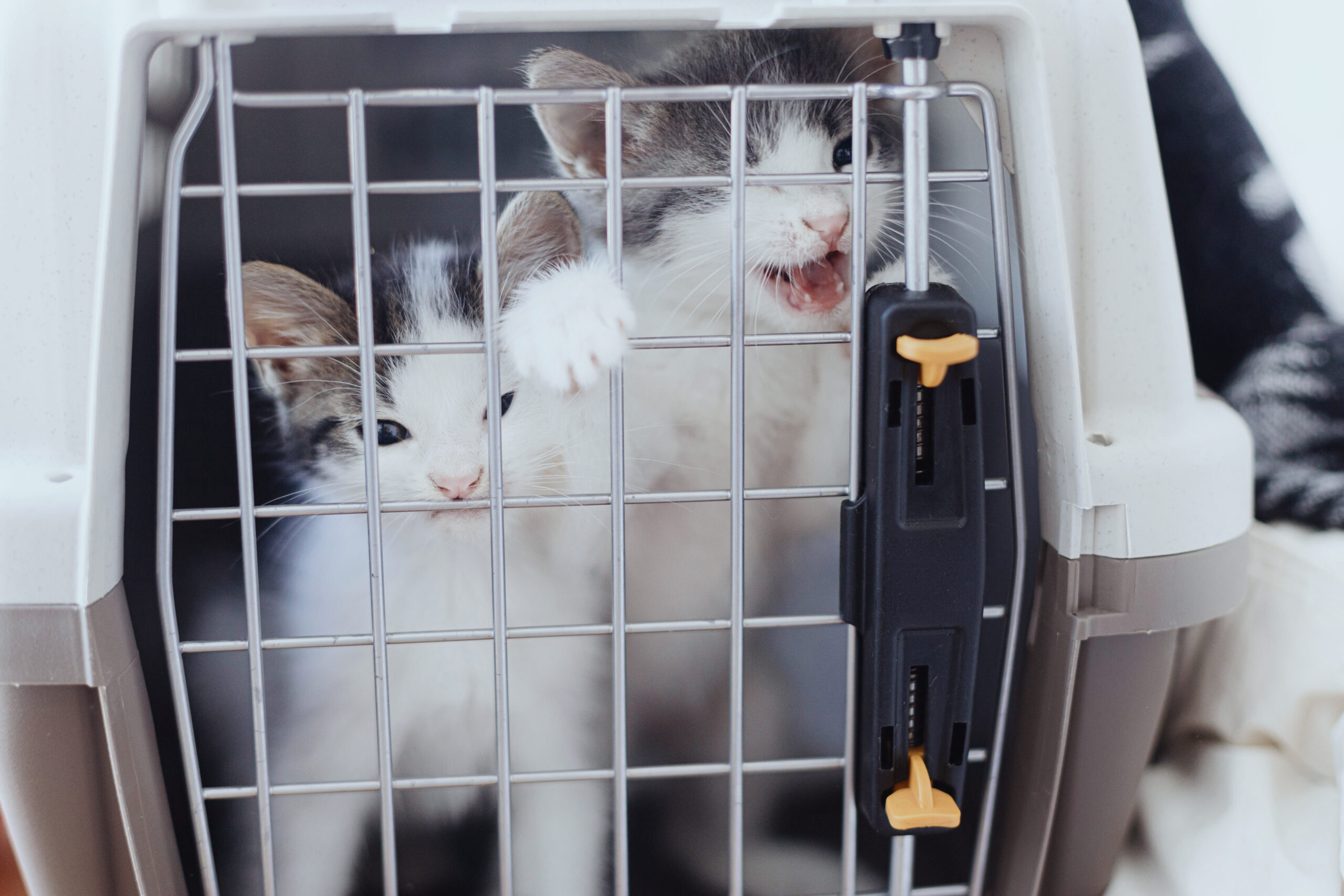How to Safely Get Your Cat in a Carrier

Although cats are the most common type of pet, they are taken to the veterinarian much less frequently than dogs. It can be challenging to educate a cat to go into its carrier if it does not get out very often (unless it is an outdoor cat, which is not the case). As a cat owner, you are certainly well aware that your cat may sometimes be pretty obstinate. When it comes to getting them to do something they don’t want to, it’s nearly impossible to win them over. This may make some cat owners have a tough time putting their feline companions into their carriers.
This is the page for you to read if you’re looking for advice on how to get a combative cat into a carrier. We will discuss ways to make your cat more peaceful so that you can put them in their carrier with less yelling and clawing.
advertisement
The First Method: Accustoming Oneself To The Environment
Suppose you don’t have enough time to educate your cat on how to use the carrier. Read Step 2 for advice on how to force your cat into the carrier regardless of whether or not they want to get in there. However, remember that doing anything like this to your cat can produce exponential amounts of stress, which can be detrimental if they are already unwell. If your cat is already ill, exposing them to further pressure could worsen its condition. If your cat is already sick, putting them through something like this could worsen its situation. Before the patient goes to their next checkup, it is in everyone’s best interest to devote the necessary amount of time and care to acclimating them to their carrier.
To get started, find a visible spot in your house to put the carrier your cat will be travelling in. The majority of cats are brilliant animals. Your cat will likely anticipate what will happen if you only take out the carrier when you intend to transport it somewhere. Instead, get into the habit of letting it sit there without interfering with it.
Helping your cat become accustomed to its carrier by associating it with positive experiences is one of the most effective methods. Follow the instructions below to prepare your cat for its trip in the carrier, whether for a trip or a trip to the vet. If you know your cat needs to be in their carrier, follow these steps.
- Clean the carrier well two weeks before you plan to transport your cat to get rid of any smells it could find irritating. Chemical odours could be present if the item were not rinsed well enough, or musty odours could be present if it had been stored for too long.
- Place the carrier in an area your cat frequents and where your pet may easily see it. Keep the door to the carrier open, so interested individuals can look inside if they want.
- Include a blanket or bed that smells like your cat and portrays things they enjoy having with them and are comfortable with in the carrier. This might be anything from a bed to a blanket that smells like your cat. Your cat will be more interested in the carrier due to this change.
- As the appointment draws near, tempt your cat to enter the carrier by placing their favourite snacks inside. This will allow you to catch them in the act.
- It will be easier for them to get used to having the carrier nearby if you position it close to their food and water bowls. After they have shown signs of being comfortable with the carrier, put the bowls inside. While they are still in the carrier, please provide them with food and water.
Your cat will come to connect the carrier with pleasant experiences if you go through the process described above without ever pushing it into the carrier. It would help if you didn’t have to put too much effort into convincing the cat to come inside when the time comes for it to do so.
The second option involves bringing your cat with you in a carrier:
Even after several weeks of gradually exposing your cat to new things, it’s possible that you won’t be able to win him over. If this is the case, you will need to devise an alternative strategy to take them with you on your trip or to the veterinarian if you have made those plans.
The Purrito Way of Doing Things
- The Purrito Technique is recommended for hostile cats who do not like being transported in carriers. This method shields you from your cat’s claws and keeps them from being overly enthusiastic and harming themselves while you attempt to place them in their transport container.
- The Purrito method involves rolling up your cat like a burrito until they are small enough to be transported in a carrier. To begin, hide the carrier from them in a location where they won’t be able to find it, particularly if they’ve become conditioned to respond negatively when they see it. You can carry this out while they are napping or in a different part of the house.
- Place the transporter so the door can be opened and points up toward the ceiling. It should be placed in a secure spot, such as the back of a toilet, with the top of the object pressed against a wall for support. It is in your best interest to position the carrier in a space that contains a minimum of items of furniture that your cat could potentially hide behind.
- Make use of a thin bath towel or a blanket suitable for cats. Be sure that it is large enough to wrap your cat in it and contain all of its legs and paws but that it can also be folded up to be thin enough to fit through the entrance at the front of the carrier while it is in use.
- Bring your cat along with you, along with the carrier, and enter the room. Instantaneously, please close the door to prevent them from escaping.
- Approaching your cat calmly and assuredly, wrap them in the towel like a burrito, leaving only their head exposed outside the covering. To prevent them from escaping, the wrap must be pulled tightly enough over the top of the object. Just make sure that it doesn’t get in the way of them being able to breathe normally.
- Put the purritos in the carrier with their tails facing down so the other person can’t see that you are putting them inside. As soon as they reach the bottom, it would help if you closed the door to the carrier. You are not required to remove the towel from its wrapping. They will unwrap themselves in a short amount of time.
- If you give them rewards via the door once the treats have been unwrapped, they may begin to link the carrier with positive things.
We advocate giving the acclimatisation procedure another shot each time they have to get into the carrier, even if it is unsuccessful the first time around. When you need to rapidly get a hostile cat into a page but don’t have time to teach them, this method is excellent because it allows you to do so with minimal effort. On the other hand, doing something too frequently can have the opposite effect of what you intend and make them despise it even more.
advertisement
How to make your cat more relaxed
After the cat has been placed into the carrier, you need to put your strategy into action to maintain the cat’s composure while it is in the carrier. It is in everyone’s best interest to prevent them from being so anxious that they hurt themselves somehow.
The following is a list of some tips that can help you successfully relax your cat on the way to the veterinarian:
- Apply a synthetic cat pheromone spray to the towel you are using or to the towel you place inside the carrier.
- Maintain vigilance on your cat while it is contained within the carrier. Even if you leave them stranded and alone for a few moments, it can cause them to experience anxiety.
- You may get your cat used to being transported in the carrier without taking it to the veterinarian by giving it practice rides in the car while it is inside the carrier. Feed them snacks in the carrier after they have emerged from it.
- If your cat, on the other hand, has a negative association with being placed in a carrier, you may need to resort to more extreme methods to secure their safety. To ensure that your pet is as relaxed as possible during their exams, the veterinarian may suggest giving them a sedative.

Featured Articles

Greebles and Cats: The Origin and the Meaning
You may have seen an internet sensation concerning cats labeled “greebles.” Feel out of the loop? We’re here to help you. In 2019, Reddit user /user/literallyatree commented on a Reddit post about a cat that looks like it’s trying to slap a ghost. This user commented: “My family calls things…

Polydactyl Cats: Just More Beans to Love
Polydactyl cats have become extremely popular in recent times. As a result, more and more people are interested in learning more about this six-toed cat and want to get one of their own. If you are a cat lover intrigued by polydactyl cats, you have come to the right place….

Why Do Cats Roll Over Into Their Backs But Not Let You Touch Their Bellies?
It’s common knowledge dogs love to have their tummies rubbed when they freely lay down before you and roll onto their backs. But, if you’re also familiar with cats, you know that when they roll onto their backs with their bellies exposed, rubbing the belly will most likely result in…